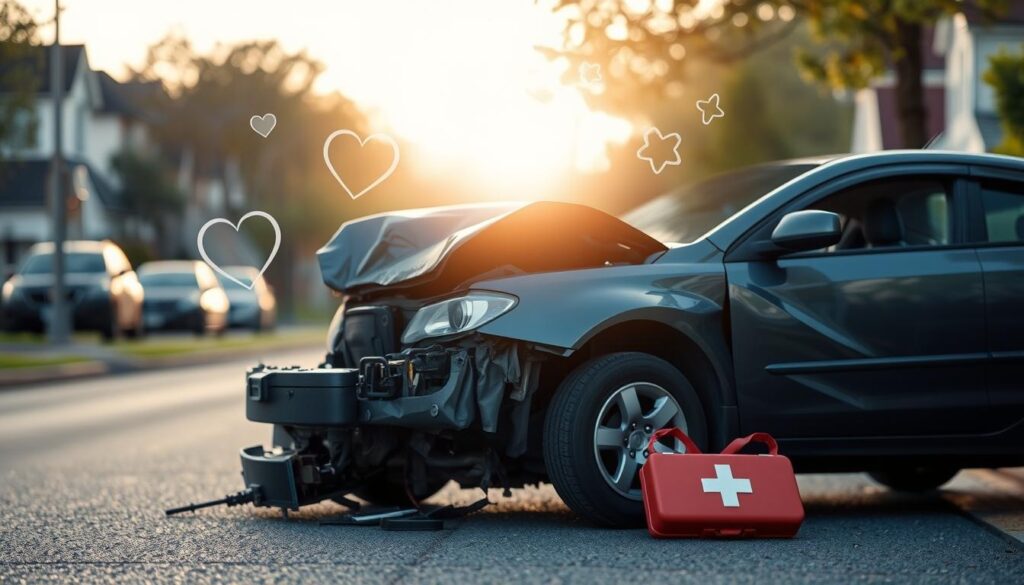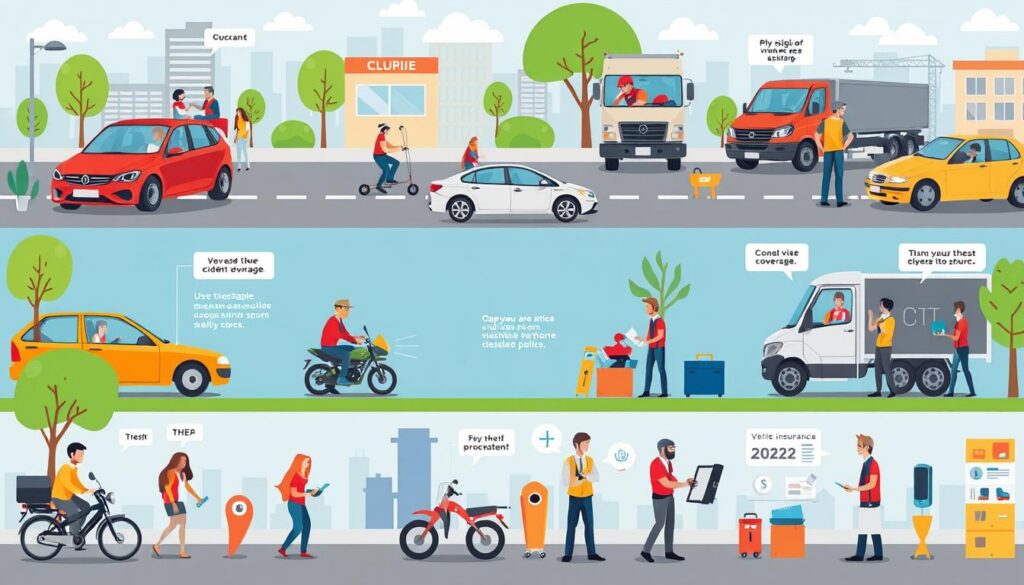As you drive in the USA, the right vehicle insurance is key. In 2024-2025, auto insurance will change, offering more protection. This guide will cover the top uses of vehicle insurance in the USA. We’ll look at different coverage types, their importance, and how they help you as a driver.
Key Takeaways
- Understand the mandatory and optional vehicle insurance coverage types in the USA for 2024-2025.
- Explore state-specific insurance requirements to ensure you meet the legal obligations in your area.
- Discover the basic components of vehicle insurance, including liability, collision, and comprehensive coverage.
- Learn about the importance of liability insurance as your primary protection against financial and legal risks.
- Explore the benefits of comprehensive and collision coverage in safeguarding your vehicle investment.
Understanding Essential Vehicle Insurance Coverage Types
Vehicle insurance has many types of coverage. It’s important to know them. This knowledge helps you choose the right insurance for your needs.
Mandatory vs Optional Coverage Options
Every state has its own liability insurance rules. This insurance helps if you cause an accident. On the other hand, collision coverage and comprehensive insurance are not required. They protect your car in accidents or other unexpected events.
State-Specific Insurance Requirements
- Each state has its own rules for liability insurance.
- These rules can change, so knowing them is key.
- Not following these rules can lead to fines or losing your license.
Basic Coverage Components
A standard auto insurance policy includes several parts:
- Liability insurance covers damages and injuries you cause.
- Collision coverage helps if your car gets damaged in an accident.
- Comprehensive insurance protects against theft, vandalism, or natural disasters.
- Personal injury protection (PIP) or medical payments coverage helps with medical costs.
- Uninsured/underinsured motorist coverage protects you if hit by someone with little or no insurance.
Knowing about these coverage types helps you make smart choices. It ensures you have the right insurance for your needs.
Top Uses Vehicle Insurance in USA 2024-2025
In today’s world, having car insurance is a must. As we look ahead to 2024-2025, there are many reasons to get good coverage. These include following the law, protecting your money, and feeling secure.
One key reason for car insurance is the law. In the US, states require drivers to have liability insurance. This is to cover damages and injuries they might cause in an accident. Not having it can lead to big fines, losing your license, and even jail time.
Car insurance also helps with the high cost of fixing cars. With new car tech and complex designs, repairs are getting pricier. So, having full coverage is smart to keep your money safe.
- Legal compliance with state insurance requirements
- Financial protection against rising vehicle repair costs
- Peace of mind in the event of an unexpected accident
- Potential insurance discounts for safe driving and other factors
The auto insurance world is changing too. Now, there’s more focus on custom coverage and new ways to save. This includes policies that reward good driving and programs that give feedback and insurance discounts.
“The primary function of car insurance is to provide financial protection, but it also offers valuable peace of mind in the face of the unexpected.”
The need for good car insurance in the USA will only grow. By knowing the benefits and what’s new, drivers can make smart choices. This helps protect their cars, money, and overall safety on the road.
Liability Insurance: Your Primary Protection
Liability coverage is key in vehicle insurance. It protects you and your money. It covers costs from accidents where you might be to blame, like injuries and damage to others’ property.
Bodily Injury Liability Coverage
Bodily injury liability insurance pays for medical bills and lost wages of people hurt in accidents you cause. It helps avoid huge medical costs and lost income claims. This keeps your finances safe.
Property Damage Liability Protection
Liability insurance also covers damage to others’ property in accidents you cause. This includes fixing or replacing the other driver’s car and any other damaged property.
Legal Defense Coverage Benefits
Liability insurance helps with legal costs if you’re sued. The legal process is complex and expensive. Your insurance can protect your rights and interests.
Getting good liability insurance is smart for car owners. It shields you from big financial hits from accidents. Knowing about liability insurance means you’re well-protected and can drive with confidence.
Comprehensive Coverage: Beyond Collision Protection
Comprehensive insurance does more than just protect your car from crashes. It shields your vehicle from many unexpected events. This gives you peace of mind while driving.
This coverage option is made for damages not caused by a crash. It protects against theft, vandalism, natural disasters, falling objects, and animal collisions. So, whether it’s a hailstorm, a fallen tree, or a rogue shopping cart, you’re covered.
Comprehensive insurance also helps if your car gets stolen. It can cover the cost of repairs or a new car. This means you can get back on the road fast, without much disruption.
It also covers towing and storage costs if your car needs repairs. This is very helpful in emergencies. It means you won’t have to pay for these unexpected costs.
The insurance claims process is easier with comprehensive coverage. Unlike collision claims, which often involve other insurance companies, comprehensive claims are handled by your own. This makes getting repairs faster and simpler.
When looking at car insurance coverage options, think about comprehensive insurance. It offers a wide range of protection. This gives you confidence and peace of mind on the road.
Collision Insurance: Safeguarding Your Vehicle Investment

Collision insurance is key to a full car insurance policy. It protects your vehicle when it hits something else, like another car or a tree. Knowing how collision coverage works helps you keep your car safe.
Deductible Options and Coverage Limits
Choosing collision coverage means picking a deductible and coverage limits. The deductible is what you pay first before insurance helps. Deductibles range from $250 to $1,000, with higher deductibles lowering car insurance rates.
Coverage limits set the max your insurance pays for repairs or a new car. It’s important to think about these when picking your coverage.
When to File Collision Claims
Figuring out when to file a claim is hard. It can affect your insurance discounts and car insurance rates. File a claim if repairs cost more than your deductible and the damage is big.
But, don’t file for small damages. The cost of fixing minor issues might be less than your deductible. Filing for small damages can raise your premiums later.
| Deductible | Average Cost of Collision Coverage | Potential Savings with Higher Deductible |
|---|---|---|
| $250 | $500 | – |
| $500 | $450 | $50 |
| $1,000 | $400 | $100 |
By thinking about deductibles and when to file claims, you can protect your car. And still keep your car insurance rates in check.
Personal Injury Protection and Medical Payments

In the world of vehicle insurance, personal injury protection (PIP) and medical payments coverage are key. They protect you and your passengers. These options cover your medical costs and lost wages, no matter who was at fault.
PIP, or “no-fault” insurance, pays for medical bills, lost wages, and more after a crash. It’s great in states with no-fault insurance. It makes the insurance claims process easier.
- PIP covers medical costs like ambulance rides and hospital stays.
- It also pays for lost wages and childcare expenses while you recover.
- Each state has different rules for PIP and uninsured motorist protection, so it’s important to know yours.
Medical payments coverage pays for your medical bills, no matter who’s at fault. It helps with doctor visits and hospital stays. It’s useful if you don’t have health insurance.
| Coverage Type | Key Benefits | Typical Limits |
|---|---|---|
| Personal Injury Protection (PIP) |
|
$10,000 – $50,000 |
| Medical Payments |
|
$1,000 – $10,000 |
Knowing about personal injury protection and medical payments helps keep you and your family safe. It’s important to have these coverages in case of an accident, no matter who’s at fault.
Uninsured and Underinsured Motorist Coverage
In the world of vehicle insurance, one key coverage is often missed: uninsured and underinsured motorist protection. It’s crucial for protecting you from financial harm caused by drivers without enough insurance or none at all.
Gap Protection Benefits
Uninsured motorist coverage helps when the at-fault driver’s insurance isn’t enough. It covers your medical bills, lost wages, and car repairs. This way, you get the help you need without financial stress.
Hit-and-Run Incident Coverage
This coverage also helps in hit-and-run cases. If the driver runs away, you can still get help. It makes dealing with the aftermath easier and ensures you’re not left to pay for everything yourself.
In today’s world, uninsured motorist protection is more important than ever. It gives you peace of mind and financial security on the road. Knowing its benefits and having the right coverage makes facing insurance claims easier, no matter what happens.
Modern Insurance Technologies and Telematics
The car industry is changing fast, and so is the insurance world. New technologies are making insurance more personal and based on real data. Telematics, which combines telecom and informatics, is key. It lets insurers track your driving and how you use your car in real time.
Usage-based insurance (UBI) uses telematics to create policies just for you. It looks at how you drive, like how fast you go and how well you brake. This way, you might get lower rates if you drive safely. It’s all about making insurance fit your life better.
Now, with self-driving and electric cars coming, insurance is facing new challenges. Insurance for self-driving cars will have to figure out who’s at fault in accidents. And electric cars might need special coverage for their batteries and charging needs. Insurers are working hard to keep up with these changes, so your insurance stays good and keeps up with the times.
FAQ
What are the top uses for vehicle insurance in the USA in 2024-2025?
In the USA, vehicle insurance is key for legal reasons, financial safety, and peace of mind. It covers damages and injuries you might cause to others. It also helps with your own vehicle’s repairs and medical costs if you’re in an accident.
What are the different types of auto insurance coverage?
Auto insurance comes in several types. Liability insurance helps if you hurt someone else. Collision and comprehensive cover your own car. Uninsured/underinsured motorist protection and personal injury protection offer extra safety.
How do mandatory and optional auto insurance coverages differ?
Mandatory insurance is needed by law in most places. It includes minimum liability limits. Optional coverages, like collision and comprehensive, offer more protection but aren’t always required.
What are the basic components of a typical auto insurance policy?
A typical policy includes several key parts. These are bodily injury liability, property damage liability, and coverage for your own car. It also includes protection for uninsured drivers and medical costs. The details can vary based on your state and policy choices.
How does liability insurance provide primary protection for drivers?
Liability insurance is the core of auto insurance. It protects you if you cause an accident that hurts others or damages their property. It covers their medical bills and repairs, and any legal fees if you’re sued.
What does comprehensive insurance cover beyond collision protection?
Comprehensive insurance covers damage not caused by a collision. This includes theft, vandalism, natural disasters, and animal hits. It helps protect your car from many unexpected dangers.
How does collision insurance protect your vehicle investment?
Collision insurance pays for repairs if your car is damaged in a crash. It helps keep your car’s value safe by covering repair costs. This way, you can file a claim to fix your vehicle.
What are the benefits of personal injury protection and medical payments coverage?
Personal injury protection (PIP) and medical payments coverage help with medical bills and lost wages. They do this whether you were at fault or not. These benefits are crucial for recovery financially.
How does uninsured and underinsured motorist coverage protect drivers?
This coverage helps if you’re hit by someone without insurance. It covers your medical and repair costs. It’s a safety net against financial loss in such cases.
How are modern insurance technologies and telematics changing the auto insurance industry?
New tech like telematics and usage-based insurance are changing insurance. They make policies more tailored to you. They reward safe driving and offer better coverage for new car types.
Stay with yugalglobal.com to get more content.

